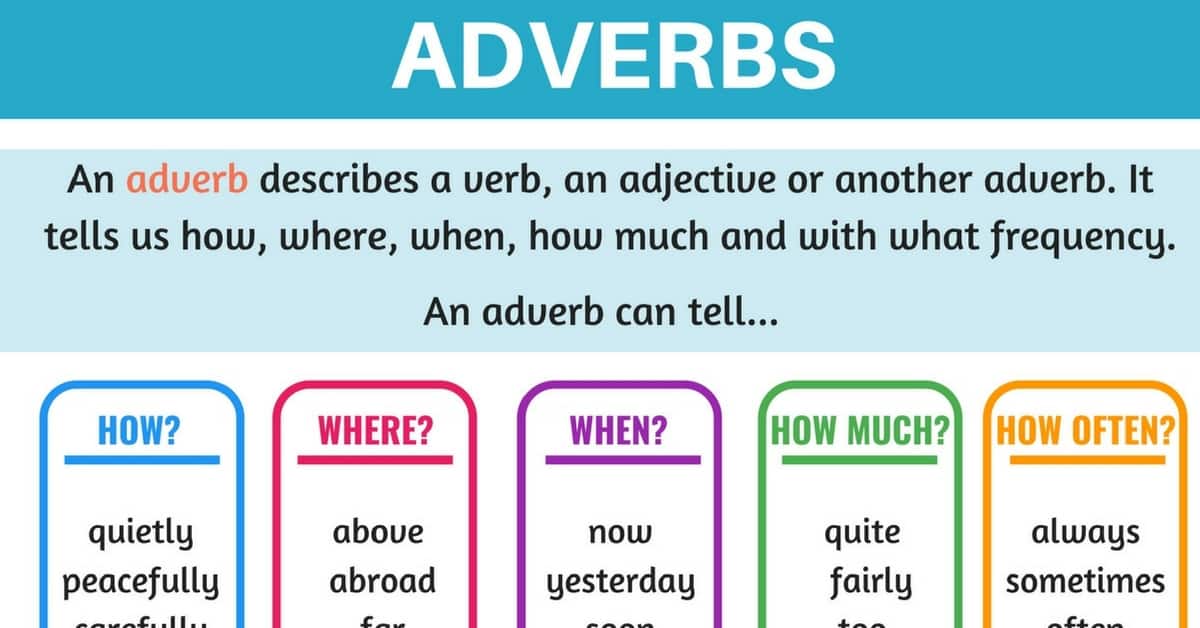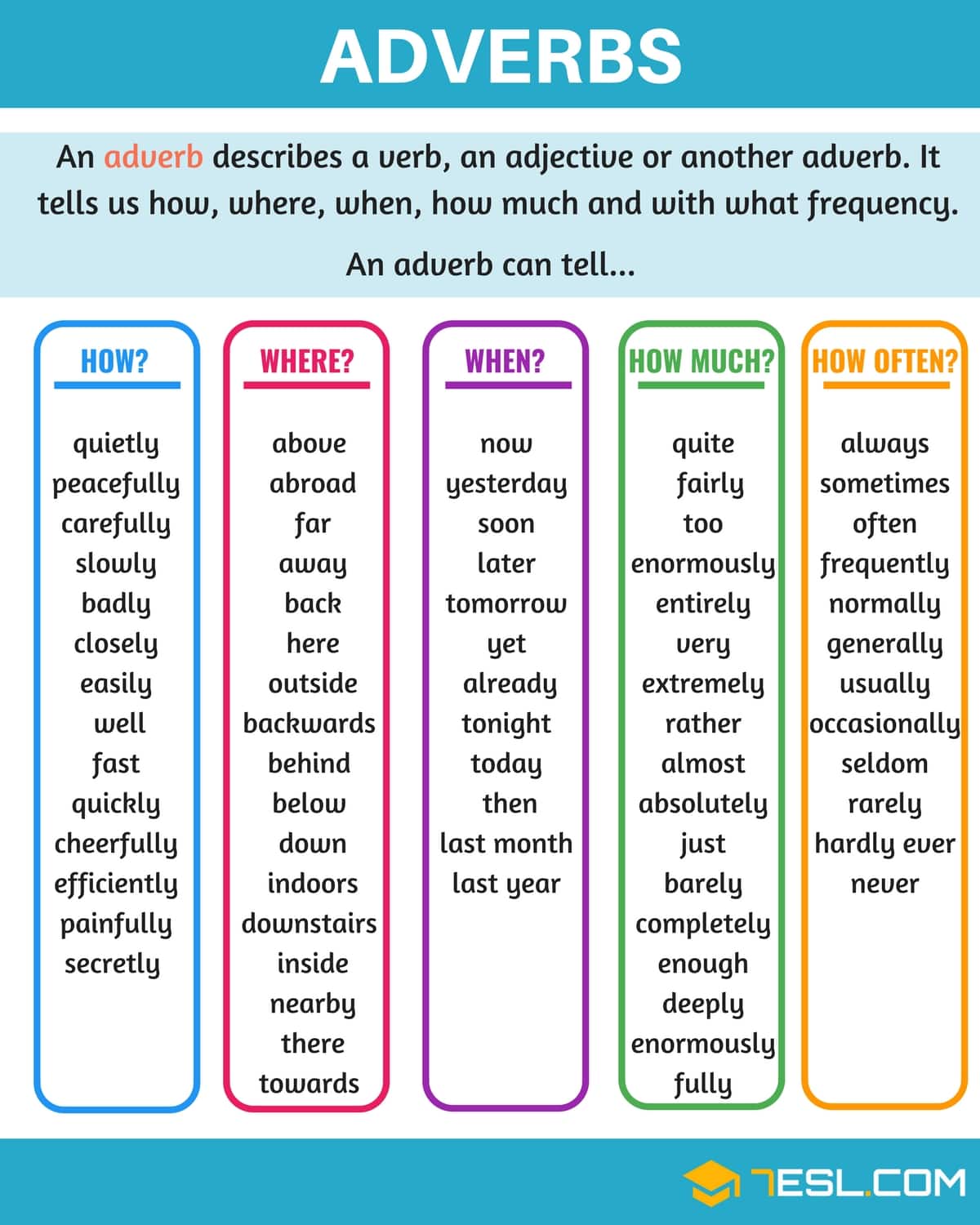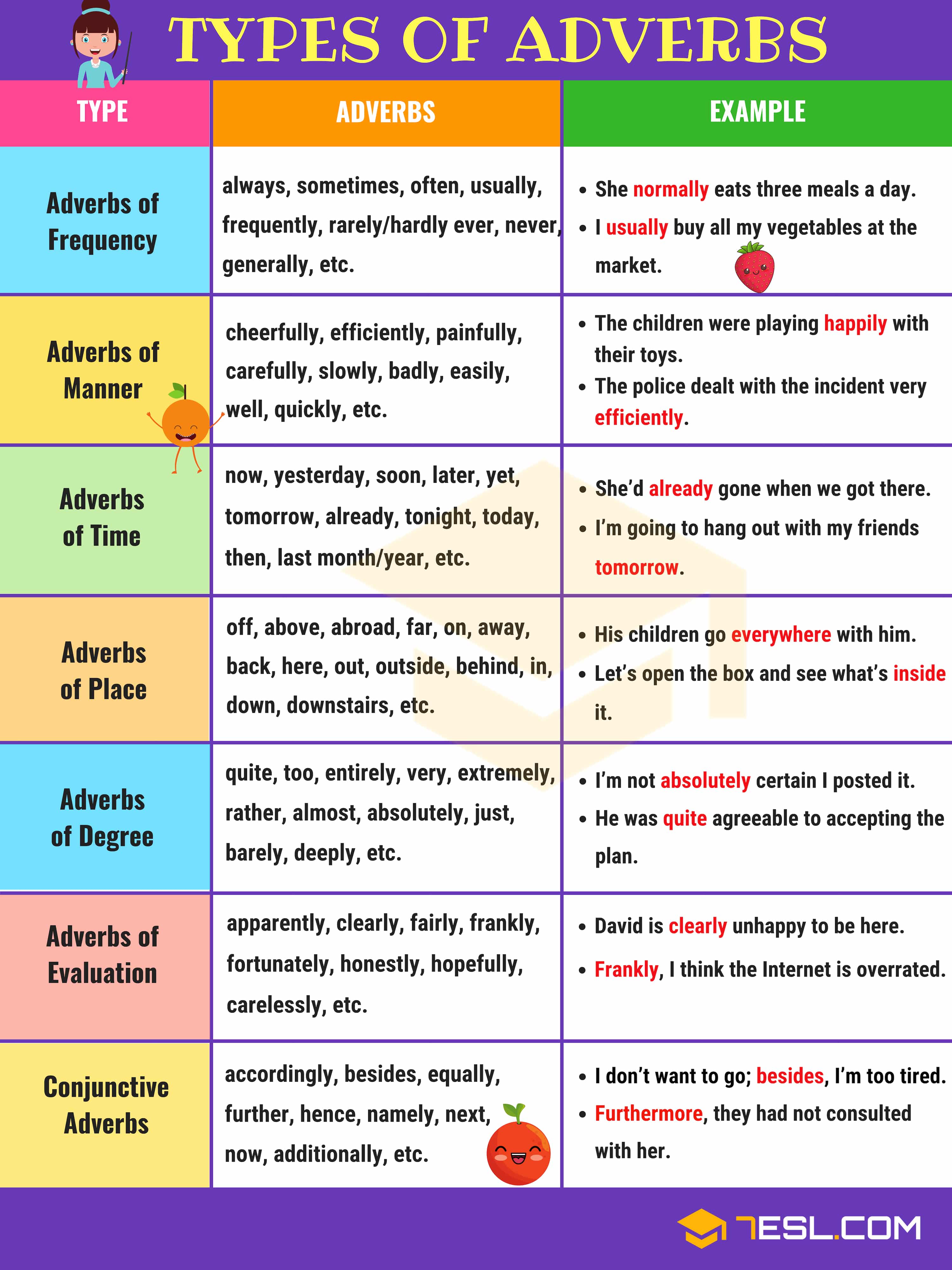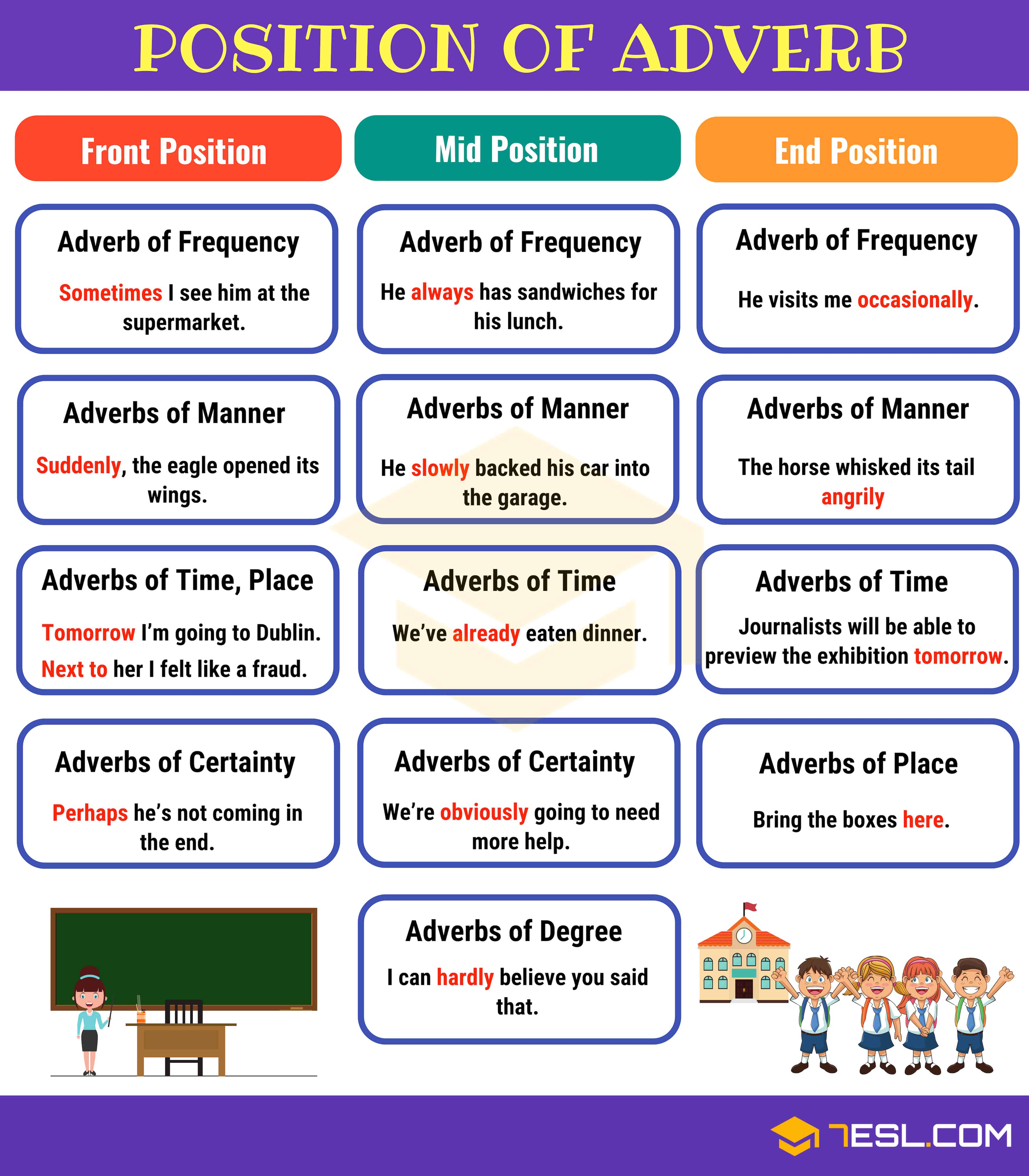What is an adverb? You have more than likely heard about the adverb, but what is its purpose within English grammar? In this article, we are going to find out exactly what an adverb is as well as how it can be used within a sentence. We are going to look at a variety of examples of adverbs being used as a way to further gain an understanding of their function. Learn adverb definition, different adverb types and useful grammar rules to use adverbs in sentences with ESL printable worksheets and example sentences.
Adverb
What is an Adverb?
The most simple way to describe an adverb is that it is a word that can modify a verb, in other words describe it, for example ‘she runs quickly.’ The verb in this sentence is “runs”, and this has been modified with the adverb quickly. They may also modify an adjective to add further information, such as ‘he is quite fat.” In this sentence, the adjective fat has been modified by the adverb quite. Finally, an adverb can be used to modify an entire sentence, for example ‘Luckily, I had enough money.’ In this example, we see that the adverb luckily modifies the rest of the sentence in its entirety.
So, what is an adverb? An adverb is a part of speech used to describe a verb, an adjective or another adverb. It tells us how, where, when, how much and with what frequency.
Adverb Examples
For the most part, an adverb will end in the letters -ly, however, there are some exceptions to this such as the word fast, which appears exactly as the adjective counterpart for the word but serves as an adverb.
- This is a fast car
- This car can drive fast.
In the first sentence, the word fast is being used as an adjective, however, in the second, it is being used as an adverb. Let’s take a look at some further examples of adverbs within a sentence.
- My sister swims badly.
- The soccer match ended quickly.
- Fortunately, my friends were not late for my birthday party.
Adverb Definition and Examples
Adverbs
As we mentioned, the adverb can be used to modify various different types of words. We are now going to take a closer look at each of these and how it works.
Adverbs with Verbs
An adverb can be used to talk about how an action is happening. You might think about this as the adverb being used to answer the question “how does something happen?’ or ‘In what manner does it happen?’ Some examples of this are:
- My dog barks loudly.
- He will seriously think about this idea.
We can see here that the adverbs answer the questions ‘how does your dog bark?’ or ‘how will you think about this idea?’ In the most simple terms, if you want to find out how an action has been performed, an adverb will answer this.
It is important to remember that adverbs should not be used with a linking verb, examples of these might be to smell, to feel, to seem, to appear or to taste. If you consider the following sentence you will see that the adverb does not fit, and that an adjective might be more appropriate.
- He feels terribly about the death of his aunt.
We mentioned that adverbs describe how an action takes place but with a linking verb, it is required to describe what is taking place, for example what he is feeling. This would mean that an adjective would work better, take a look:
- He feels terrible about the death of his aunt..
Adverbs with Adjectives and other Adverbs
An adverb also has the ability to modify either another adverb or an adjective. This is a great way to cause the adjective to become more intense and descriptive, giving a much more clear indication of what is being spoken about. Consider the phrase “he is tall.” The adjective here is tall, but with the use of an adverb, we can describe how tall he is. Look at the sentence once it has been modified:
- He is very tall.
Here are some more examples of how an adverb can modify an adjective.
- My sister is rather attractive.
- The beach was unexpectedly busy.
- My teacher is always well dressed.
You might also use an adverb to modify another adverb, take a look at the following example:
- The food here is almost never good.
The adverb almost is being used to modify the adverb never and both of these are being used to modify the word good.
When you are using an adverb with another adverb, there is the possibility to go as far as you would like and use several adverbs together, however you should err on the side of caution with this since it can make a sentence weak. It is preferable to choose one or two adverbs to make your sentence stronger and less bulky. Let’s look at an example of a sentence with too many adverbs.
- My father shouts quite horrifically too loudly.
You can understand what the sentence is trying to tell us but the use of adverbs is a little too much.
Adverbs to Modify a Sentence
An adverb can be used to modify a whole sentence and in this case will appear usually at the beginning. When used in this way, the adverb is not talking about any specific thing but is rather being used as a way to give an overall feeling for all of the information presented. Some examples of this are:
- Generally, people take the train into London.
- Luckily, my family lives in a nice location.
- Interestingly, the ancient people ate the same meats as we do.
Adverbs for Comparison
In some cases, you might use an adverb to make a comparison. You can do this by adding the words more or most in front of the adverb. Let’s look at the progression of this in the following sentences.
- He ran quickly.
- He ran more quickly
- He ran the most quickly.
Adverb Examples (with Different Types)
There are different types of adverbs expressing different meanings. Generally, adverbs tell us how, where, when, how much and with what frequency. Therefore, types of adverbs are classified according to their functions.
List of adverbs in English with different types and examples.
- Adverb of Frequency: always, sometimes, often/frequently, normally/generally, usually, occasionally, seldom, rarely/hardly ever, never, etc.
- Adverb of Manner: cheerfully, efficiently, painfully, secretly, quietly, peacefully, carefully, slowly, badly, closely, easily, well, fast, quickly, etc.
- Adverb of Time: now, yesterday, soon, later, tomorrow, yet, already, tonight, today, then, last month/year, etc.
- Adverb of Place: off, above, abroad, far, on, away, back, here, out, outside, backwards, behind, in, below, down, indoors, downstairs, etc.
- Adverb of Degree: quite, fairly, too, enormously, entirely, very, extremely, rather, almost, absolutely, just, barely, completely, enough, etc.
- Adverb of Certainty: apparently, clearly, definitely, doubtfully, doubtlessly, obviously, presumably, probably, undoubtedly, etc.
- Adverbs of Attitude: frankly, fortunately, honestly, hopefully, interestingly, luckily, sadly, seriously, surprisingly, unbelievably, etc.
- Adverbs of Judgement: bravely, carelessly, fairly, foolishly, generously, kindly, rightly, spitefully, stupidly, unfairly, wisely, wrongly, etc.
- Conjunctive Adverb (Linking adverb): besides, comparatively, conversely, equally, further, hence, in comparison, incidentally, namely, next, now, rather, undoubtedly, additionally, anyway, certainly, elsewhere, finally, in addition, in contrast, indeed, moreover, nonetheless, similarly, subsequently, thereafter, yet, also, meanwhile, consequently, nevertheless, etc.
Where Should You Place An Adverb?
When deciding on where to place your adverb within a sentence it is important to remember to place it as near as possible to the word it is going to modify.
If the word you are modifying is a verb then the adverb should be placed in the middle of the sentence, for example:
- He swam effortlessly across the pool.
It is important to consider the adverb ‘only’ as this can often be misplaced and has the ability to change the meaning of the sentence. Look at the two following examples:
- I only fed my bird.
- I fed only my bird.
The first sentence explains that I fed my bird but did nothing else with it, whereas the second sentence explains that I fed my bird and not any other birds.
Different types of adverbs and adverbials go in different positions in the clause. Let’s learn these adverb positions in a sentence, also called adverb placement.
- The front position: before the subject of the sentence. It gives information in advance, to set the scene for the action that follows.
- The mid position: the adverb in this position is intimately connected with the verb, generally placed immediately before it. If there is an auxiliary verb, the adverb is placed between the auxiliary and main verb. In case there are two, it is placed between them. If there is a negative auxiliary, the adverb normally goes after the negative element, but we can emphasize negation by placing the adverb just before it.
- The end position: at the end of the sentence.
English Adverbs Video
An adverb is a very useful word which can modify other words such as verbs and adjectives to give them further description and intensity. There are certain rules explained in this video, which should be followed when using an adverb and you should be careful about where you choose to place them within a sentence to avoid altering the meaning.












0 Comments